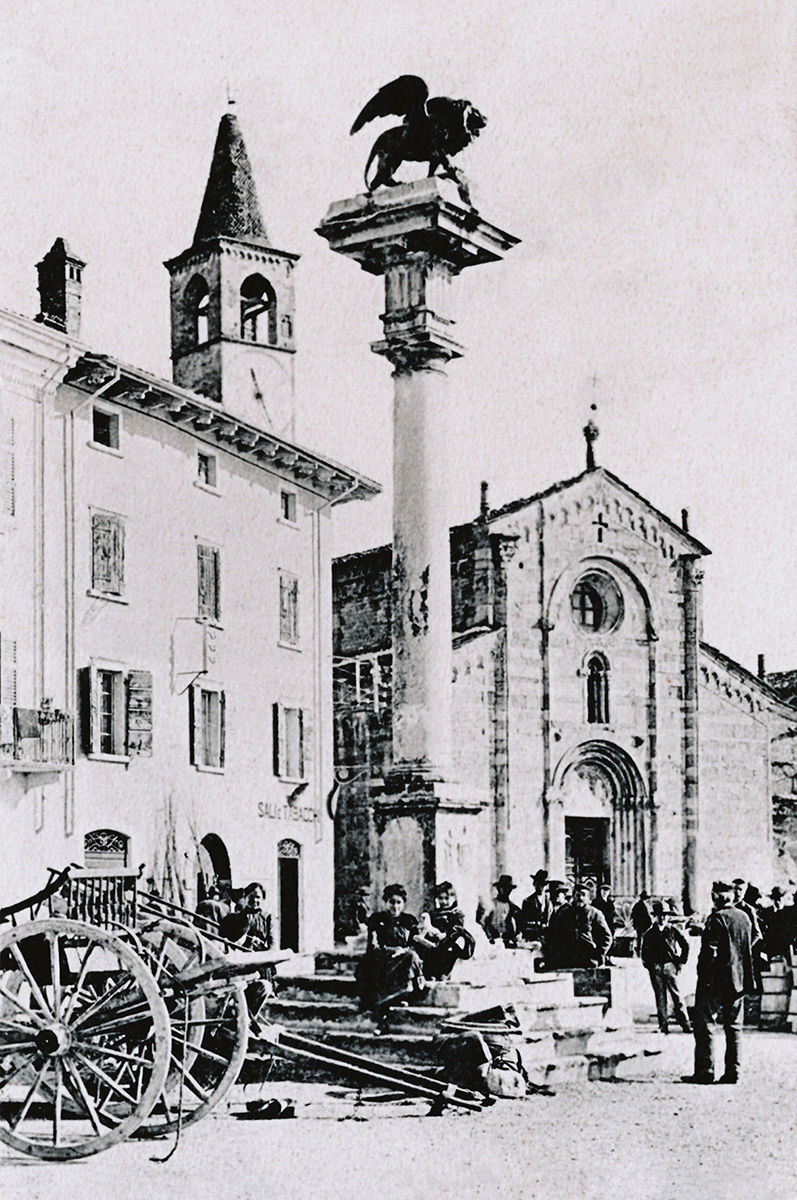 Piazza S. Marco
Piazza S. Marco
La fotografia che stai osservando ritrae la piazza S. Marco, al centro della quale svetta la colonna marciana, simbolo della Repubblica di Venezia che dominò il territorio dal 1426 fino al 1797. La colonna venne eretta di fronte all’antico Municipio di Maderno nel 1610. Un tempo presentava 5 gradini (ora solo 3) e sulla sua sommità svettava una statua in pietra raffigurante il leone alato con il Vangelo recante la scritta "PAX TIBI MARCE EVANGELISTA MEUS". Alla fine del Settecento, caduta la Serenissima, il leone alato venne abbattuto. La colonna rimase così spoglia fino al 1902, quando fu collocato il nuovo leone in bronzo, questa volta senza Vangelo, donato al Comune dallo scultore Ettore Ximenes, per adempiere ad una promessa fatta anni prima in occasione di una visita al suo amico Giuseppe Zanardelli che dimorava a Maderno.
 Piazza S. Marco
Piazza S. Marco
Das Foto, das Sie anschauen, zeigt den Piazza S. Marco, in dessen Mitte die Marcussäule steht, ein Symbol der Republik Venedig, die das Gebiet von 1426 bis 1797 beherrschte.
Die Säule wurde 1610 vor dem alten Rathaus von Maderno errichtet. Einmal hatte sie 5 Stufen (jetzt nur noch 3) und auf ihrer Spitze stand eine Steinstatue, die den geflügelten Löwen mit dem Evangelium mit der Inschrift "PAX TIBI MARCE EVANGELISTA MEUS “ darstellt.
Ende des achtzehnten Jahrhunderts fiel die venezianische Republik und der geflügelte Löwe wurde zerstörb.
Die Säule blieb so unverziert bis 1902, als der neue bronzene Löwe ohne Evangelium gesetzt wurde, das der Bildhauer Ettore Ximenes der Gemeinde schenkte, um ein Versprechen zu einzuhalten, das er Jahre zuvor anlässlich eines Besuchs bei seinem Freund Giuseppe Zanardelli, in Maderno, gemacht hatte.
 Piazza S. Marco
Piazza S. Marco
This photograph depicts Piazza San Marco and its central Column, named after St. Mark the patron saint of Venice. It is a ruling power sign of the Venetian Republic in control of this territory from the year 1426 to 1797. In the year 1610 the Column was set up in front of the ancient Town Hall. It consisted of 5 steps (now only 3) and at its top stood a stone sculpture of the Lion of Saint Mark, pictured in the form of a winged lion holding the Gospel of Saint Mark that bore the inscription “PAX TIBI MARCE EVANGELISTA MEUS” which means “Peace be with thee, O Mark, my evangelist”. At the end of the 18th Century with The Fall of the Republic of Venice the winged lion was removed The column remained without the winged lion until 1902, when a bronze lion was put back again, this time without the Gospel. It was a gift to the Municipality from the sculptor Ettore Ximenes, to fulfil the promise he made years before to his friend Giuseppe Zanardelli who lived in Maderno at that time.
